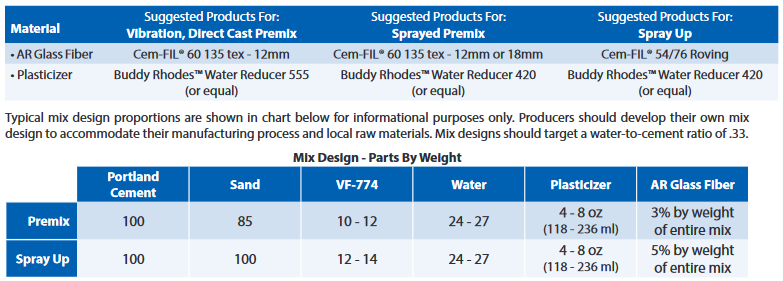| Article number: | 66VF774C |
| Availability: | Out of stock |

Features
The Primary Benefits of Using Forton™ VF-774 are:
• Elimination of the seven day wet cure required to achieve the maximum strengths of the GFRC composite.
• Significant improvements in the long-term durability of the GFRC composite, especially the maintenance of the long-term flexural strain to failure property, i.e. ductility of the composite.

Other Advantages to Using Forton™ VF-774:
• Improved workability of the mix at low water/cement ratios, further enhancing the strength of the cured cement matrix.
• Easy spraying of vertical surfaces without having the face mix sag.
• Complete dispersion of iron oxide pigments for batch-to-batch color consistency of face mixes.
• UV stability of the Forton™ polymer means architectural finishes maintain their “as produced” colors.
• Hard cured face mixes for better sand blasting uniformity.
• Tighter, denser cured product, which reduces absolute moisture absorption and vapor permeability while at the same time significantly reducing the rate of absorption as a function of time.
• Elimination of crazing and spider cracking in the face mix due to the soft polymer particles in between the cement particle and the sand grain.
PCI Compliance: Forton™ VF-774 complies with Appendix G of MNL 130, the Manual for Quality Control for Glass Fiber Reinforced Concrete Products from the PCI for the elimination of the seven day wet cure.
Instructions
HANDLING & STORAGE - Forton™ VF-774 is supplied in 5-gallon pails (40 lbs/18 kgs), 55-gallon drums (480 lbs/218 kgs) and totes (2,300 lbs/1,043 kgs). VF-774 should not be allowed to freeze. Recommended storage temperature range: 50°F - 100°F (10°C - 38°C). VF-774 should be stored in closed containers out of direct sun light and away from direct sources of heat.
SHELF LIFE - Shelf life of VF-774 is one year in unopened containers when properly stored. Smooth-On cannot guarantee shelf life of opened or repackaged units. Important: This product has limited shelf life. Use as soon as possible after opening.
PRE-MIXING - VF-774 can separate over time in storage or transit as evidenced by caramel liquid on the surface. Gently stir with a paddle for 30 seconds. Pre-mixing one time per 24 hour usage cycle is recommended.
MEASURING & MIXING - Assemble all components and accessories before you begin.
Required Materials:
Important: Components should be mixed in proper sequence. Standard concrete mixers may be used, but it is recommended to use a high shear mixer specially designed for GFRC to ensure a thoroughly mixed, lump free slurry is produced.
Step 1: Weigh or batch all materials.
Step 2: Add all liquids, including VF-774 and 2 oz. of plasticizer, to mixer.
Step 3: Start mixer on slow (300-500 rpm).
Step 4: Add pigment if used.
Step 5: Add sand.
Step 6: Add cement and increase mixer speed to high (1,000-1,800 rpm).
Step 7: Mix for 1 - 2 minutes.
Step 8: Add the remaining plasticizer to achieve desired workability.
Step 9: Reduce mixer speed to slow (300-500 rpm) and gradually add fiber (Premix only) until dispersed (typically not more than one minute). Important: Mixing too long or at too high a speed after fiber has been added can filamentize or damage the fiber, resulting in placement issues and reduced strengths.
APPLYING A RELEASE AGENT - Common mold materials include mold rubber, melamine coated board and birch faced plywood or FRP with tooling resin gel coat. Use a high quality release agent meant for releasing architectural concrete such as Crete-Lease 20 VOC to release GFRC castings from the mold.
Casting - Pour mixture in a single spot at the lowest point of mold, and let mixture seek its level. Vibrating: After casting, consolidate the slurry and remove entrapped air using a vibrating table or hand vibrator.
Spraying - For higher volume of smaller parts or making large cladding panels, GFRC slurry can be sprayed into molds using rotor/stator or peristaltic pumps specifically designed for GFRC. Regardless of spray pump used, a face coat without fiber is typically applied first. After the face coat has properly stiffened, a fiber backup mix is applied in multiple passes, with proper compaction following each pass. For low volume application - A hopper gun (Kraft EZY Deck Pro is recommended) can be used to apply face mix. GFRC back up mix can be applied by hand.
Curing - After placement, cover GFRC with plastic tarp / sheeting to prevent excessive moisture loss and maintain heat of hydration to ensure a proper initial cure. Let cure in the mold for 12-16 hours. Curing temperatures should be maintained above 50°F/10°C in order to ensure proper film forming of the VF-774.